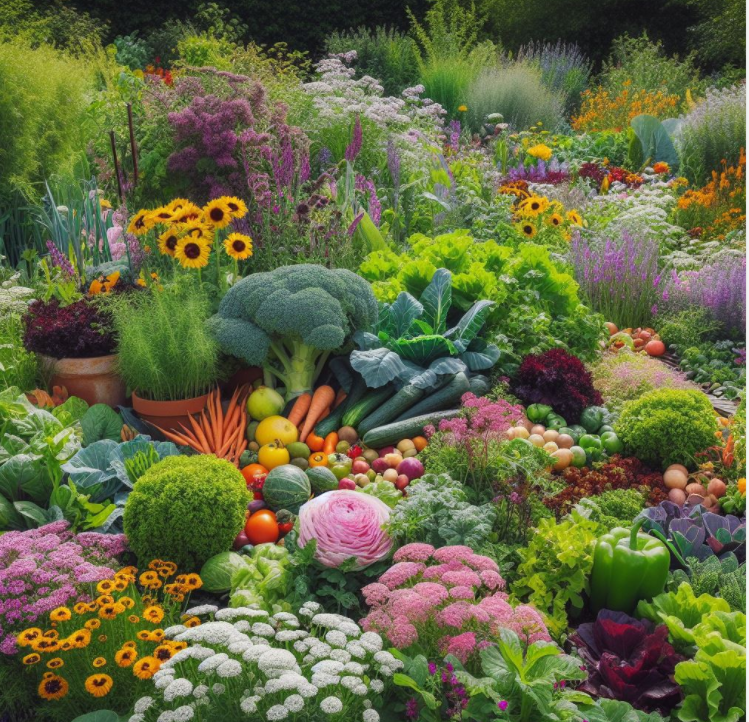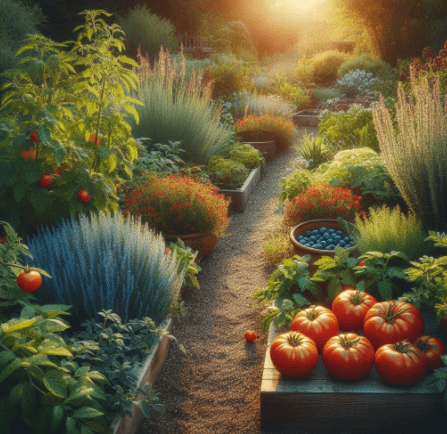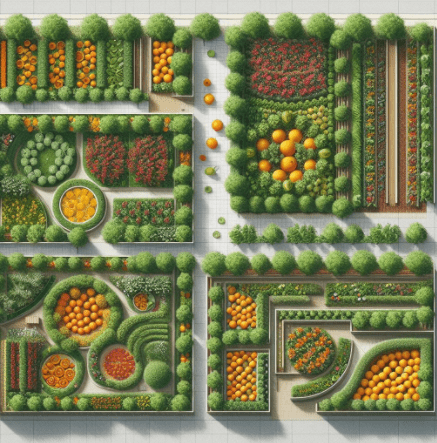
In an age where sustainability and organic living take center stage, gardening goes beyond aesthetic flower beds and becomes about interconnected ecosystems and functional beauty. Edible landscaping, incorporating food-producing plants into ornamental settings, offers a delightful way to merge the functional with the enchanting.
Whether you’re a greenhorn gardener or a seasoned sustainability enthusiast, this comprehensive guide will help you confidently step into the world of edible landscaping, turning your property into a veritable feast for the eyes and the table.
The Essence of Edible Landscaping
Essentially, edible landscaping is about creating a visually pleasing and productive space. It’s a seamless fusion of the sensual and the practical, encouraging eco-friendly living while making the most of your outdoor space. This approach isn’t just about reducing your grocery bill, although that’s certainly a bonus; it’s a lifestyle choice that offers numerous benefits, from promoting local biodiversity to fostering a deeper connection with nature.
The Flavors of the Garden

Imagine stepping outside your door and plucking a sun-kissed tomato, a handful of fragrant basil, or a few crisp lettuce leaves straight from your garden path. Edible landscaping unlocks a world of fresh flavors. Beyond vibrant vegetables, consider the tangy sweetness of strawberries nestled amongst your flowers, the pop of blueberries from patio bushes, or the year-round zest of herbs like rosemary and thyme.
Even dwarf fruit trees can grace your yard, offering peaches, apples, or citrus, depending on your climate—fragrant basil or crisp lettuce straight from your garden path. Edible landscaping enables the city dweller, suburbanite, or rural homesteader to bring a taste of the countryside – and the farm-to-table movement – to their doorstep.
Beyond the Vegetable Patch
While the vegetable garden is a central part of edible landscaping, it’s not the only player in the game. Berry bushes, fruit trees, and herbs can seamlessly blend with ornamental trees, shrubs, and perennials to create a multifaceted, year-round tableau of bloom and bounty.
Getting Started with Your Edible Landscape
The prospect of transforming your property into an edible haven can feel daunting, but you can cultivate a flourishing garden with a clear plan and some simple ‘seeds’ of knowledge.
Plotting Out Your Layout
Begin by evaluating your space. Where is the best sunlight? Do any existing structures or fixed elements supporting climbing plants or creating microclimates? Sketch out a basic plan, considering the natural flow of your landscape and potential barriers like shade from buildings or trees.
Selecting the Seeds of Change
Your region and climate will dictate what you can grow. Research what plants thrive in your area and list your favorites. When selecting edible ornamentals, consider soil quality, frost dates, and seasonal rainfall patterns.
Designing Your Edible Oasis

With the basics in place, it’s time to get creative. Here are some design principles to help you weave your edible plants into a visually appealing tapestry.
Harmony in Growth
Mix and match your edibles with traditional ornamental plants to create a diverse and resilient landscape. Consider your plants’ height, color, and texture, aiming for a balanced composition that’s as pleasing to the palate as it is to the eye.
The Power of Partnerships
Companion planting, the practice of growing mutually beneficial species together, can increase yield and reduce the need for chemical interventions. For example, plant marigolds to protect your tomatoes, include basil with your peppers to add natural pest deterrence, or sow beans to fix nitrogen in the soil and bolster your other crops.
Tending the Edible Garden
With your garden established, regular maintenance is key to your plants’ well-being and harvests.
Watering Wisely
Determine the water needs of your plants and develop a routine that keeps them hydrated without overindulging them. Techniques like drip irrigation can be both efficient and strategic.
Feeding Your Garden
Organic fertilizers, compost, and mulch are great ways to maintain the health and fertility of your soil. Remember, rich soil leads to robust plants and tasty fruits.
Pest and Disease Patrol
Opt for natural remedies to keep your garden free of unwelcome guests. Neem oil for aphids and floating row covers for pests are gentle and effective solutions.
Reaping What You Sow
The joy of edible landscaping is not just in the growing but also in the reaping and savoring of your harvest.
Harvesting at the Right Time
Learning when and how to harvest different crops is an art. Some, like salad greens, can be picked continuously, while others, like melons, require a keen nose for ripeness.
Preserving Nature’s Bounty
Enjoy the fruits of your labor all year round by preserving your harvest. Canning, freezing, and drying are popular for keeping summer flavors in your kitchen well into winter.
The Benefits of an Edible Landscape
Edible landscaping offers numerous advantages that extend beyond the garden gates.
A Sustainable Stand
Reducing food miles and practicing water-wise gardening contribute to a more sustainable food system. Every tomato you grow is a small step toward a greener, more self-sufficient future.
Health on a Plate
Fresh, homegrown produce is not just tastier; it’s also healthier. You control what goes into the soil and on your plants, ensuring that you and your loved ones eat food that’s free of harmful chemicals.
Beauty and the Bite
Edible landscapes are a joy to behold, especially when vibrant crops mingle with flowering plants’ beauty and fruit-bearing trees’ majesty. It’s a feast for the soul as well as the senses.
Inspirational Edible Landscapes
Take a tour of successful edible landscaping projects showcasing how beautiful and productive these gardens can be. Real-world examples illustrate the range of possibilities, whether you have a small urban plot or acres of open land.
Before and After Snapshots
Nothing is quite as inspiring as a dramatic transformation. Browse through snapshots of gardens that have evolved from plain lawns or overgrown backyards into oases of edibility and attractiveness.
Cultivating a Harvest Year After Year
The path to a flourishing edible landscape is an ongoing one. Join a community garden group, attend workshops, and share your experiences on social media or through online forums. The more you engage with like-minded enthusiasts, the more your own garden will grow — in knowledge, in bounty, and in the joy it brings to your life and the environment.
Sharing the Bounty
There’s something wonderfully communal about edible landscaping. Whether you’re exchanging seeds with a neighbor or donating a portion of your harvest to a local food bank, sharing the bounty is a powerful way to connect with others and give back to your community.
Reflection and Recalibration
Every garden teaches its caretaker something new. Reflect on your gardening experience and be open to recalibrating your design, plant choices, and maintenance strategies. The beauty of an edible landscape is its adaptability and the endless opportunities for learning and growth — both for you and for your garden.
The essence of edible landscaping is as much in the process as in the product. It’s about nurturing a slice of nature that nourishes your body, offers respite for your soul, and weaves you into the vibrant tapestry of the Earth’s ecology. Ready to create your own edible oasis? With this beginner’s guide, a dash of patience, and a generous handful of enthusiasm, you’re well on your way to sowing the seeds of change — one beautifully fruitful garden at a time. So go forth and let your garden thrive! It’s a journey of discovery, growth, and endless rewards. Keep learning, keep experimenting, and most importantly, keep enjoying the delicious fruits of your labor. Happy gardening!
As you continue on this journey of edible landscaping, remember that there is always room for creativity and experimentation. Don’t be afraid to try new techniques and plant combinations, and don’t get discouraged if something doesn’t work out as planned. Every garden is unique and constantly evolving, just like nature itself. Embrace the process and enjoy the bounties that your garden provides.
And remember, edible landscaping is not just about growing food; it’s also about creating a more sustainable and beautiful world

























